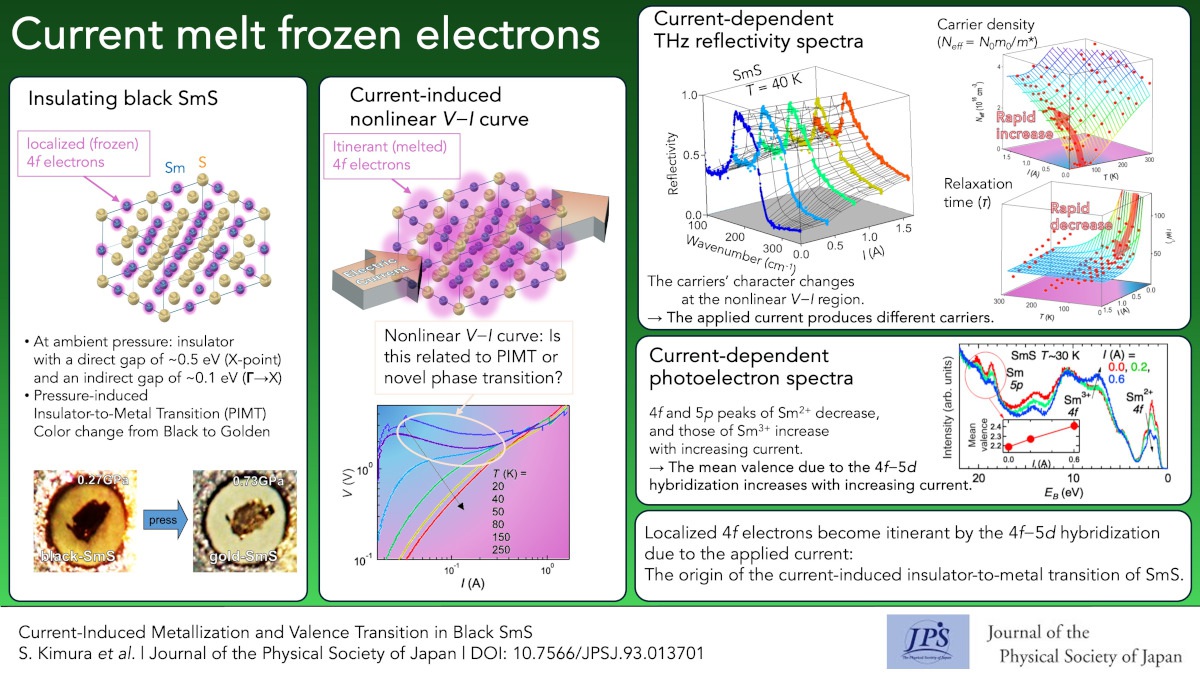Current Melt Frozen Electrons
© The Physical Society of Japan
This article is on
Current-Induced Metallization and Valence Transition in Black SmS
(JPSJ Editors' Choice)
J. Phys. Soc. Jpn.
93,
013701
(2024)
.
The origin of the current-induced insulator-to-metal transition of samarium monosulfide was explained by the 4f−5d hybridization observed using optical reflectivity and photoelectron spectroscopies.

Different external environments, such as temperature and pressure, can change physical properties, such as transport, magnetism, and light transparency. One phenomenon is the Pressure-induced Insulator-to-Metal Transition (PIMT), in which a transparent, nonconducting material (insulator) becomes opaque and begins to conduct electricity (metallization) when pressure is applied. Some materials exhibit the PIMT at pressures below 10,000 atm (approximately 1 GPa). One substance that exhibits PIMT at low pressure is samarium monosulfide (SmS), an insulator at ambient pressure (1 atm) with high electrical resistance and transmits infrared and terahertz regions. When SmS is damaged by a needle tip or applying pressure above approximately 7,000 atm (~0.7 GPa), it undergoes PIMT and transforms into a metal. This property change, as well as the color change of SmS from black to golden-yellow, has attracted the attention of many researchers and has been the subject of numerous studies. However, the origin of PIMT is yet to be identified, even more than 50 years after its discovery.
More recently, the behavior of SmS in external environments that differs from that of pressure has attracted attention. The first is the negative differential resistance (dV/dI) when a current higher than the normal measurement condition is applied to SmS at low temperatures. Because ordinary materials obey Ohm's law, dV/dI is constant regardless of the current magnitude. However, SmS exhibits negative dV/dI at low temperatures, where the voltage decreases when the current is increased.
Here, the origin of dV/dI was investigated using optical reflectivity spectra in the region from the terahertz to vacuum-ultraviolet and angle-integrated photoelectron spectra under the application of current. The obtained spectra suggest that the material exhibited a Current-induced Insulator-to-Metal Transition (CIMT). Detailed analysis of the electronic state change revealed that the CIMT was caused by the hybridization of the Sm 4f orbital and Sm 5d conduction band owing to the pushing out of the 4f electrons localized in the atom by the applied electric current. The metallic state of the CIMT has a lower conduction electron density than the metallic phase of the PIMT of SmS, suggesting that the same phase transition in the PIMT cannot occur by increasing only the 4f-5d hybridization strength. This result suggests that effects other than hybridization are required for PIMT.
(Written by S. Kimura on behalf of all the authors)
Current-Induced Metallization and Valence Transition in Black SmS
(JPSJ Editors' Choice)
J. Phys. Soc. Jpn.
93,
013701
(2024)
.
Share this topic
Fields
Related Articles
-
Higher-Order Topological Phases in Magnetic Materials with Breathing Pyrochlore Structures
Electronic structure and electrical properties of surfaces and nanostructures
Magnetic properties in condensed matter
Mathematical methods, classical and quantum physics, relativity, gravitation, numerical simulation, computational modeling
2025-4-7
A simple example of a higher-order topological phase, in which the symmetry decreases step-by-step from the bulk to the corner, is realized in a magnetic system with a pyrochlore structure and is characterized by a series of quantized Berry phases defined for the bulk, surface, and edge.
-
Existence of Chiral Soliton Lattices (CSLs) in Chiral Helimagnet Yb(Ni1-xCux)3Al9
Magnetic properties in condensed matter
2025-4-1
Our study examines the magnetic structure of the monoaxial chiral helimagnet Yb(Ni1-xCux)3Al9, providing first direct evidence of the formation of chiral soliton lattice state.
-
Understanding Pressure-Induced Superconductivity in CrAs and MnP
Magnetic properties in condensed matter
2025-3-10
This study reviews existing research on the pressure-induced variation of magnetic properties of transition metal mono-pnictides like CrAS, MnP, and others, aiming to understand the unconventional superconductivity observed in CrAs and MnP.
-
Symmetry and AI: Building the Future of Physics Simulations
Magnetic properties in condensed matter
Measurement, instrumentation, and techniques
2025-2-18
Generative artificial intelligence (AI) has gained considerable attention in scientific fields. By embedding physical symmetry into AI before training, we created a faster and lighter model. Scaling improves the accuracy and unlocks the potential of physics research and applications.
-
Triangular Lattice Magnet GdGa2: Spin Cycloids and Skyrmions
Cross-disciplinary physics and related areas of science and technology
Electronic transport in condensed matter
Magnetic properties in condensed matter
2025-2-3
Careful measurements were conducted on the hexagonal magnet GdGa2 to reveal the experimental signatures of ultrasmall spin cycloids and of a potential Néel-type skyrmion lattice phase induced by a magnetic field.




